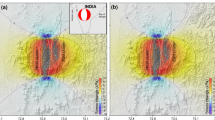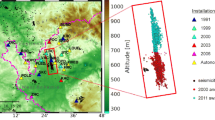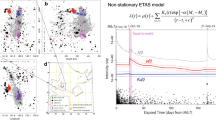Abstract
The Hualien city is located near the pole of rotation induced by the along-strike transition from Ryukyu subduction to the collision between the Luzon arc and the Chinese continental margin in northeastern Taiwan (Rau et al., J Geophy Res 113: B09404, 2008). Such a tectonic regime creates varied seismogenic structures that are responsible for the ruptures of the 1951 M L 7.3 Hualien-Taitung earthquake sequence (Chen et al., J Geophy Res 113: B02304, 2008), the 2018 M w 6.4 Hualien earthquake sequence (e.g., Rau and Tseng, Terr Atmos Ocean Sci 30: 281–283, 2019), the 2021 M L 6.2 Shoufeng earthquake sequence, and numerous and persistent moderate-to-small size earthquake swarms in the Hualien area. This special issue was introduced by the several month-long 2021 episode of moderate-to-small size earthquake swarms occurred in the Hualien area (Figs. 1 and 2, Central Weather Bureau, 2022). The 2021 Hualien earthquake episode includes small-to-moderate-size earthquakes that release minute strain energy on the small asperities and larger events (M > 5.5) that ruptured nearby asperities. Figure 3 shows the spatiotemporal distribution of the Hualien earthquake sequence between April 1 and December 31 of 2021. The 2021 Hualien earthquake sequence provides us a great opportunity to examine the earthquake physics, characteristics, seismogenic processes, and the early warning algorithm of an earthquake swarm, which are the key elements for the understanding of generation of earthquakes. In this special issue, we have collected six papers that detailed various aspects of the 2021 Hualien earthquake sequence, which provide us a better understanding of the nature of the Hualien earthquake swarms.

The crustal (≤ 40 km) Hualien earthquake swarm activities observed from April to December of 2021. Star symbols show the epicenters of the largest three earthquakes in this time period. Rainbow color represents the focal depth of each event. The radius of each circle is proportional to the observed ML

The temporal distribution of seismicity in the upper 40 km beneath this area observed from April to December of 2021. Several swarm activities can be identified, in which intense seismicity happened within a short time interval. The main earthquake swarms occurred from April to July of 2021. Numbers indicate the days after April 1st, 2021

The spatiotemporal distribution of the Hualien earthquake swarm activities from April to December of 2021. The symbol color represents the time in days after April 1st, 2021
Similar content being viewed by others
Avoid common mistakes on your manuscript.
1 Introduction
The Hualien city is located near the pole of rotation induced by the along-strike transition from Ryukyu subduction to the collision between the Luzon arc and the Chinese continental margin in northeastern Taiwan (Rau et al. 2008). Such a tectonic regime creates varied seismogenic structures that are responsible for the ruptures of the 1951 ML 7.3 Hualien-Taitung earthquake sequence (Chen et al. 2008), the 2018 Mw 6.4 Hualien earthquake sequence (e.g., Rau and Tseng 2019), the 2021 ML 6.2 Shoufeng earthquake sequence, and numerous and persistent moderate-to-small size earthquake swarms in the Hualien area.
This special issue was introduced by the several month-long 2021 episode of moderate-to-small size earthquake swarms occurred in the Hualien area (Figs. 1 and 2, Central Weather Bureau 2022). The 2021 Hualien earthquake episode includes small-to-moderate-size earthquakes that release minute strain energy on the small asperities and larger events (M > 5.5) that ruptured nearby asperities. Figure 3 shows the spatiotemporal distribution of the Hualien earthquake sequence between April 1 and December 31 of 2021. The 2021 Hualien earthquake sequence provides us a great opportunity to examine the earthquake physics, characteristics, seismogenic processes, and the early warning algorithm of an earthquake swarm, which are the key elements for the understanding of generation of earthquakes. In this special issue, we have collected six papers that detailed various aspects of the 2021 Hualien earthquake sequence, which provide us a better understanding of the nature of the Hualien earthquake swarms.
Hwang et al. (2022) constructed the relationship between radiated seismic energy, ES and earthquake magnitude, ML for the 2021 ML 5.8 and ML 6.2 Shoufeng, Hualien earthquake sequence to investigate if the stress state at the rupture source varies with size of the earthquake. They obtained a relationship of logEs ∝ 2.0ML, and a crossover magnitude was determined at ML = 4.0, implying different rupture mechanisms were at play between small and large earthquakes for this sequence. They consequently suggest that for the 2021 sequence, the ML > 4.0 events obey the source self-similarity, but the ML < 4.0 events fail to comply such a relationship.
Wang et al. (2022) characterized the 2021 Hualien swarm pattern in view of multifractality in both space and time domains. They found that the multifractality exists in space for events with ML ≤ 3 and inter-epicentral distances shorter than 20 km, and in time for the inter-event intervals less than 8.8 days. Chen et al. (2022) analyzed the dominant periods and the correlation among earthquakes with different magnitude for the 2021 earthquake swarms. They found that short-term corrected memory effect existed in the 2021 Hualien earthquake sequence.
Yamada and Chen (2022) modified the extended integrated particle filter (IPFx) method, which is an automatic source determination algorithm developed for the Japanese earthquake early warning (EEW) system and applied it to the 2018 and 2021 Hualien earthquake sequences, respectively. They improved the phase association algorithm through trial and errors to prevent the contamination of higher noise level existed in the Taiwanese seismic dataset. Their results indicate good performance in detecting earthquakes with seismic intensity ≥ 4 for the 2018 Hualien earthquake sequence, and detected 14 events with M ~ 2 that were missing in the manual CWB catalog of April 18, 2021. The study of Yamada and Chen (2022) shows the practicability of IPFx method in improving the speed and accuracy of the Taiwanese EEW system.
Huang and Wang (2022) analyzed the relocated earthquake clusters for the selected events in the 2018–2021 Hualien earthquake sequences, and together with the velocity model and earthquake focal mechanisms, to assess the seismogenic structure of northern Longitudinal Valley in northeastern Taiwan. Based on their evaluations, they consider the 2018–2021 Hualien earthquake clusters represent a west-dipping fault that branched out from the deeper Central Range fault, and the fault likely truncates the east-dipping Longitudinal Valley fault beneath the northern Coastal Range. Comparably, Jian and Wang (2022) used the unsupervised machine-learning clustering algorithm and principal component analysis to analyze the 2018–2022 Hualien earthquake sequence, and investigated the rupture processes of three largest events during this sequence with the two-dimensional back-projection method. Their results indicated two seismogenic structures: a deeper west-dipping Central Range fault and a shallow clockwise rotation structure in the east coast.
Giving the collections of this special issue, we are hoping to have a better understanding of the characteristics and nature of the Hualien earthquake sequences, which may be considered as the typical example for the transition from subduction to collision tectonic regime.
References
Central Weather Bureau (CWB, Taiwan) (2022) Central Weather Bureau Seismographic Network [Data set]. International Federation of Digital Seismograph Networks. https://doi.org/10.7914/SN/T5
Chen KH, Toda S, Rau RJ (2008) A leaping, triggered sequence along a segmented fault: the 1951 ML 7.3 Hualien-Taitung earthquake sequence in eastern Taiwan. J Geophys Res 113:B02304
Chen KC, Kim KH, Wang JH, Chen KC (2022) Dominant periods and memory effect of the 2021 earthquake swarm in Hualien, Taiwan. Terr Atmos Ocean Sci. https://doi.org/10.1007/s44195-022-00022-2
Huang HH, Wang Y (2022) Seismogenic structure beneath the northern Longitudinal Valley revealed by the 2018–2021 Hualien earthquake sequences and 3-D velocity model. Terr Atmos Ocean Sci 33:17
Hwang RD, Huang YL, Chang WY, Lin CY, Lin CY, Wang ST, Chan JB, Chang JP, Lin TW (2022) Radiated seismic energy from the 2021 ML 5.8 and ML 6.2 Shoufeng (Hualien), Taiwan, earthquakes and their aftershocks. Terr Atmos Ocean Sci. https://doi.org/10.1007/s44195-022-00020-4
Jian PR, Wang Y (2022) Applying unsupervised machine-learning algorithms and MUSIC back-projection to characterize 2018–2022 Hualien earthquake sequence. Terr Atmos Ocean Sci. https://doi.org/10.1007/s44195-022-00020-4
Rau RJ, Tseng TL (2019) Introduction to the special issue on the 2018 Hualien, Taiwan, earthquake. Terr Atmos Ocean Sci 30:281–283
Rau RJ, Ching KE, Hu JC, Lee JC (2008) Crustal deformation and block kinematics in transition from collision to subduction: GPS measurements in northern Taiwan, 1995–2005. J Geophys Res 113:B09404
Wang JH, Chen KC, Chen KC, Kim KH (2022) Multifractal measures of the 2021earthquake swarm in Hualien, Taiwan. Terr Atmos Ocean Sci 33:11
Wessel P, Luis J, Uieda L, Scharroo R, Wobbe F, Smith W, Tian D (2019) The generic mapping tools version 6. Geochem Geophys Geosyst 20:5556–5564. https://doi.org/10.1029/2019GC008515
Yamada M, Chen DY (2022) Automatic hypocenter determination with the IPFx method for the 2018 Hualien earthquake sequence. Terr Atmos Ocean Sci 33:18
Acknowledgements
We thank all the authors who contributed to this special issue and to the reviewers who provided detailed comments to the manuscripts. We thank the Seismological Center of Central Weather Bureau of Taiwan for the earthquake catalogue. Figures were generated using the Generic Mapping Tools (GMT6), developed by Wessel et al. (2019). Ruey-Juin Rau has received research support from Ministry of Science and Technology, Taiwan under grant MOST 110-2114-M-006-001.
Author information
Authors and Affiliations
Contributions
R-JR and W-TL drafted the manuscript. W-TL drew the figures. All authors read and approved the final manuscript.
Corresponding author
Ethics declarations
Competing interests
The authors declare no competing interests.
Additional information
Publisher's Note
Springer Nature remains neutral with regard to jurisdictional claims in published maps and institutional affiliations.
Rights and permissions
Open Access This article is licensed under a Creative Commons Attribution 4.0 International License, which permits use, sharing, adaptation, distribution and reproduction in any medium or format, as long as you give appropriate credit to the original author(s) and the source, provide a link to the Creative Commons licence, and indicate if changes were made. The images or other third party material in this article are included in the article's Creative Commons licence, unless indicated otherwise in a credit line to the material. If material is not included in the article's Creative Commons licence and your intended use is not permitted by statutory regulation or exceeds the permitted use, you will need to obtain permission directly from the copyright holder. To view a copy of this licence, visit http://creativecommons.org/licenses/by/4.0/.
About this article
Cite this article
Rau, RJ., Liang, WT. Introduction to the special issue on the Hualien earthquake swarms. Terr Atmos Ocean Sci 33, 27 (2022). https://doi.org/10.1007/s44195-022-00028-w
Received:
Accepted:
Published:
DOI: https://doi.org/10.1007/s44195-022-00028-w




